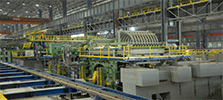OUR WORK IN THE UNITED STATES

US industry could make billions of dollars in energy savings. The Institute for Industrial Productivity provides resources to capture these savings opportunities through energy management systems, the identification of state-of-the-art and advanced technologies, such as combined heat and power and waste heat recovery systems, and other energy efficiency and low-carbon technologies and best practices.
Industry in the US
- Industry has the potential to reduce energy consumption by 18-21% by 2020 compared to baseline (with a positive net present value).
- The use of combined heat and power could generate energy savings of 910 trillion Btu (equivalent to 0.96 EJ) in 2020 compared to baseline.
Source: McKinsey (2009). Unlocking Energy Efficiency in the US Economy
Many of the most energy-intensive industries in the US have made impressive gains in energy efficiency, but international best practices show that there are still significant opportunities for energy and cost savings. Companies are increasingly looking for these kinds of efficiency improvements to address volatile energy costs and meet their corporate sustainability goals while remaining competitive in global markets. The EPA’s proposed Clean Power Plan and DOE’s Superior Energy Performance program offer compelling cases for making further reductions in industrial energy use and improving energy productivity by implementing energy management systems and investing in advanced technologies.
Projects
IIP works with its partners to develop reports, tools, workshops and case studies on key opportunities to improve industrial productivity and energy efficiency. Visit IIP’s project pages to learn more about our work on the Clean Power Plan, ratepayer programs in Minnesota and the SEE Action Network.
Technical Assistance
IIP works with a number of partners across the US to provide best practices and technical assistance on IEE and CHP. For example:
-
IIP worked with the Energy Resources Center at the University of Illinois at Chicago to develop a CHP pilot program that was introduced by the state’s Department of Commerce and Economic Opportunity.
-
IIP provides input to IEE and CHP coalitions nationally, such as the Industrial Energy Efficiency Alliance and in various states including Minnesota, Michigan, Ohio and Illinois.
Documenting best practices
With many programs, tools, and resources already available in the United States, IIP is collecting and examining this information from across the country. Sources include technical and trade organizations and government entities such as the US Department of Energy, the US Environmental Protection Agency, the National Institute of Standards and Technology (NIST), the American Council for an Energy Efficient Economy (ACEEE), the Alliance to Save Energy, the US Clean Heat & Power Association and many others.
Visit IIP’s resource library to access our range of US industrial efficiency resources.
Partners
In the United States, IIP collaborates with the Energy Foundation, the US Department of Energy’s Advanced Manufacturing Office, EPA’s Energy Star Program, the ACEEE, the Alliance to Save Energy, the Great Plains Institute, the University of Illinois Chicago’s Energy Resources Center, Lawrence Berkeley National Laboratory, Texas Industries of the Future and many others.
The Natural Resources Defense Council (NRDC) is working on a major policy research effort to develop a coal consumption cap analysis and strategy that will enable
Energy efficiency and air pollution control
China’s efforts to address its serious air pollution offer the country the perfect opportunity to simultaneously cut its energy intensity.
This 2015 report, by the Regulatory Assistance Project (RAP) and IIP, is designed to equip China’s air regulators with the tools necessary to include clean energy and energy efficiency programs in the
China Cement Association (CCA)
Natural Resources Defense Council (NRDC)



